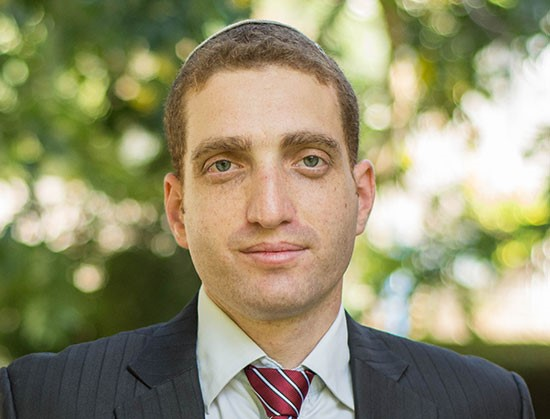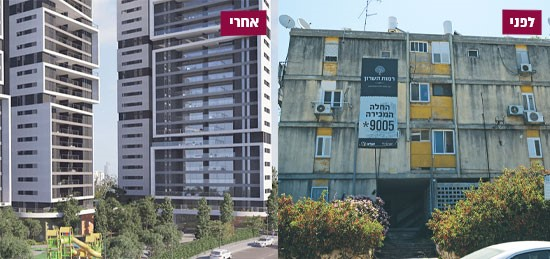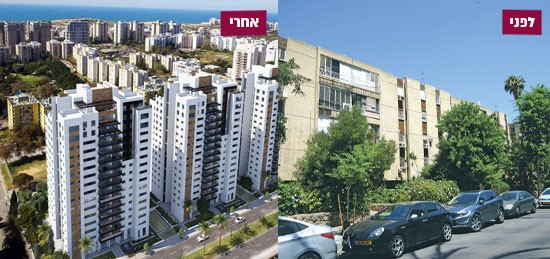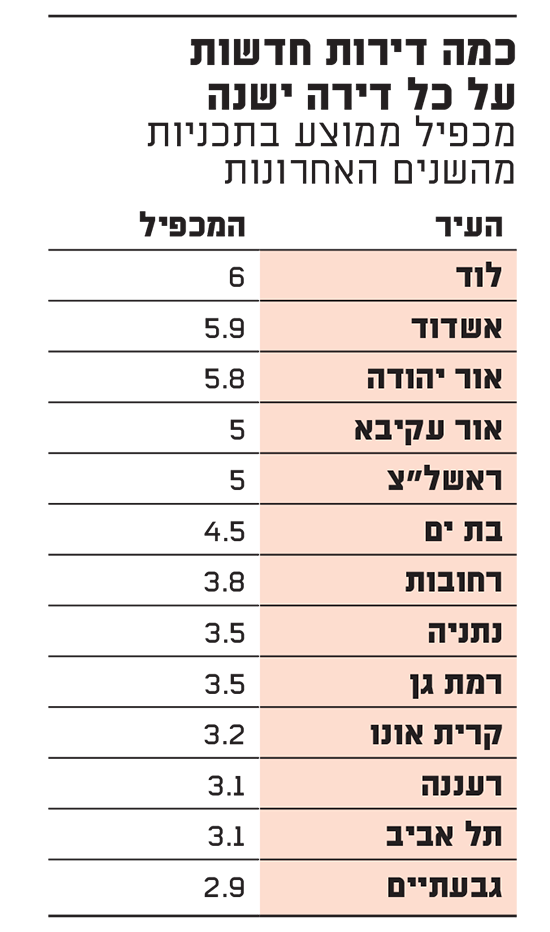Eric Mirowski, globes.co.il.
"There are quite a few places that no entrepreneur enters, because they are not economic," says Arnon Friedman, CEO of Ashdar, who is very familiar with the economic question of evacuation-construction projects. The future of such projects depends on an accurate calculation of the building rights that developers will receive - some new apartments and sometimes commercial space they will receive for each old apartment. Too much construction rights will result in financial insecurity for projects, while too many construction rights will be unprofitable for developers but could adversely affect residents' quality of life and impact on infrastructure. So how do you determine the correct scope of these rights? Appraiser Lior Yosef Badash recently conducted a comprehensive review of urban renewal projects in central Israel, trying to trace and map the multiplier formulas for those projec ts.
 Lior Yosef Badash / Photo: Eitan Blaish
Lior Yosef Badash / Photo: Eitan Blaish
The "evacuation-construction" multiplier is the ratio between the number of original housing units that were in the complex, prior to its demolition, and the number of apartments to be built in the new project. For example, if the multiplier is five, it means that for each apartment that was in the project before it was demolished, five new apartments will be built. One will be for the original owner, and the additional four will be sold in the free market.
It is true that the question of multipliers is also relevant to TAMA 38 projects, but these are quite different numbers, because due to the nature of evacuation-construction projects, the multipliers required for economics are much higher.
The findings of the test conducted in the flap are not encouraging.
Only in the very center of the country and in the heart of Gush Dan can three new apartments be satisfied with each one. Once you move away even to Bat Yam, the number of apartments needed "jumps" to classes that will be difficult to meet.
A private entrepreneur wants more, the city wants less
Badash says there are three factors that affect the multiplier: who initiated the project, the profitability of the developer, and whether or not there is an improvement levy.
1. The profitability required for the entrepreneur
"The multiplier is a function of profitability for an entrepreneur. Trying to reach a multiplier that the municipality can meet its planning implications and its impact on the environment, infrastructure, etc., and on the other hand to give the entrepreneur enough 'economic viability' to implement the project. Among other things, this is reflected in the weaker areas "Like Lod and Ashdod - where the value of apartments is lower, the required multiplier is much higher than that of Tel Aviv," says Badash.
2. Who initiated the project
The amount of multiplier required also greatly depends on who initiated the project planning. When the municipality is the entrepreneur, the multiples are usually lower, because she sees her considerations primarily in her eyes. When it comes to a national factor that initiates construction, the multiplier increases significantly, as the state wants to get as many apartments as possible and is less responsive to the needs of the local authority that is supposed to provide kindergartens, schools and welfare departments for all residents. In the case of a private entrepreneur, he would naturally try to reach as high a multiplier as possible, as the project would be more economical for him.
"Take, for example, the plan recently approved by the IDF at the SJ Agnon complex in Netanya," demonstrates Dash. "The multiplier there is higher than four. In contrast, other projects in Netanya received multiples of three. You really see the contrast between the national interest and the local interest in these programs."
3. There is or is not a surcharge
When a private entrepreneur decides to promote an evacuation-construction program, he takes an appraiser, who makes a report, that examines projected project revenue and costs that also include the apartments to be allocated to the original tenants in the new project, the proceeds to be paid to those who do not want to participate in the project, and the project's profitability. , Under a number of multiples, until a multiplier appears to be sufficient for the entrepreneur, but will also pass through the local authority.
In between, there is a big question as to whether or not the developer will be charged a levy by the municipality. If billed - that means increasing its costs, which will require a higher multiplier.
Even Bat Yam is not close enough to Tel Aviv
For the purpose of his examination, he surveyed 35 projects in the center of the country, which were approved by the planning and construction committees from the middle of the previous decade.
As a result of the test, he found "good areas" and "inferior areas". In the good areas, the average received is 3.3, which means that every new apartment you destroy will have 3.3 new apartments built. Among the complexes included in this list are the La Guardia complex in the Yad Eliyahu neighborhood of Tel Aviv, Dafna complex next to Ichilov Hospital in Tel Aviv, the Recanati complex in Tel Aviv, the Histadrut complex in Givatayim, Brandis in Ra'anana, Yoseftal and the pioneer in Ramat Hasharon, and Shlomo King's complex.

The pioneer compound in Ramat Hasharon / Photo: Eyal Yitzhar, Globes
In the areas that he defined in the medium / inferior flap an average multiplier of 4.9 was obtained. These projects include the projects in the Zionist complex in Lod, the Yoseftal axis in Bat Yam, the Irgun complex in Rehovot, the Poznanski neighborhood and the Degania complex in Rishon Lezion.
Notice, even in Bat Yam, near Tel Aviv and destined to become part of it, which is much higher than in Tel Aviv.
For the purpose of mapping, we have only here referred to programs approved in the last five years, about 20 in number.
The multipliers, and this must be emphasized, vary not only from city to city, but also from neighborhood to neighborhood; The multiplier of the Recanati compound in Ramat Aviv was the lowest found - only 2.1; In contrast, at the La Guardia complex in southern Tel Aviv, the multiplier reached 3.5.
 Recanati compound in Ramat Aviv / Photo: PR
Recanati compound in Ramat Aviv / Photo: PR
Indeed, the lowest multiples are achieved in the best neighborhoods and in the most sought-after cities, while the higher multiples are found in less-favored neighborhoods and cities, such as Lod and Ashdod.
Badash is focused on the center of the country, but if you look at what's happening outside of Gush Dan, you see the multipliers climb even higher: A few weeks ago a large evacuation project was started in the Neve David neighborhood of Haifa, Almog Company: instead of 74 apartments that have been demolished, buildings will be built 437 new apartments, ie a multiplier of 5.9 - almost six new apartments for each one. In the City Park project of Bahri, on Oak Street in Yavne, 920 apartments will be built instead of 160 - a multiplier of 5.75.

Some new apartments on each old apartment
The problem of these multipliers, which represent a nearly six-fold increase in the number of apartments to be built on these projects, will force the municipalities to respond to infrastructure, and the question of whether they can always do so. Almost always for small towns it will be especially difficult.
Over the past decade: the multipliers on the rise
One of the things that Badash has noticed is that over time the multiples rise and if in the previous decade you could find multiples smaller than three - today it is very difficult to find them.
There are several reasons for this phenomenon: One, construction standards have soared over the last decade and a half, joining the rising construction costs. Another reason is that the planning vision of the authorities is moving towards greater congestion of the cities - meaning the authorities themselves require more apartments. We have only seen this in recent weeks, when the Planning Administration announced its intention to change the overcrowding formulas, and in the policy, document promoted by the Tel Aviv municipality, according to which the number of apartments in projects will increase and their area will decrease.
The problem: In cheap neighborhoods, there is no chance for projects
One of the biggest problems with evacuation-construction projects is the subordination of planning principles to economic principles. This is taken for granted, but such projects are not only promoted based on clean planning considerations, but also based on feasibility analysis. In price rises, or in expensive neighborhoods, it is easier to carry out such projects because the economic feasibility of entrepreneurs is rising. In a situation of price declines, and in low-cost neighborhoods, you need extremely high multipliers, which actually characterize the projects.
If we go back to Comparison for TAMA 38 projects - the national master plan for strengthening earthquake structures in exchange for building rights - there you can see the economic feasibility of launching projects in Ashdod, Zichron Yaacov, Kiryat and even Acre. Urban renewal projects where the building needs to be demolished and tenants Alternative housing for a number of years is far more expensive for an entrepreneur - and the prospect of seeing it come to fruition in these areas is much smaller as a result.
Didi Yamin, a right-wing group of right-wing miracles and deputy chairman of the Ashkelon Contractors Association, told "Globes" about six months ago that he was trying to set up a project in a good location in Ashkelon and was unsuccessful because it reached multiplier seven. "Ashkelon is not even a deep periphery. There are areas beyond Beersheba, or Shlomi, that will never have urban renewal, "Yemin told us then.
It is also a matter of the considerable time that passes until the project is approved. As long as prices go up, the project remains attractive to the developer. But what happens in the event of a drop or stagnation? “When prices fall, the developer will immediately feel a drop in the revenue he should receive from the project, and he will cancel it or demand to raise the multiplier. But raising the multiplier means a change in the program and we are again in a circle that will take years," concludes Badash.
Bottom line, the test done by Badash illustrates the enormous challenge facing evacuation-construction - outside the narrowest circle and close to Tel Aviv, it scrapes the economic, or not economic at all, and the new government will have to find practical solutions.
"It's easy to get caught up in the multiplier, but a lot of things affect the economy"
Ashdar is the entrepreneur in a project at the Recanati complex in Ramat Aviv, which came out a few months ago after almost 20 years in the planning and licensing pipeline.
Arnon Friedman, CEO of Ashdar, believes that the multiplier is not everything: "It is easy to get caught up in the matter of a multiplier, as one who gives the exact result in terms of project economics. The thing is that the project's economy is not just a multiplier, but a lot of other factors that affect costs and revenue.
 Arnon Friedman, CEO of Ashdar / Photo: Eyal Yitzhar, Globes
Arnon Friedman, CEO of Ashdar / Photo: Eyal Yitzhar, Globes
"The first of these is the average area of the housing unit in the new plan. There are places where they have approved a multiplier 3, but with an average apartment area of 80 square meters; There is a place where they have approved a lower multiplier but with an average area of 110 square meters per housing unit. This greatly affects the area you give the vacant tenants.
"Seemingly, the consideration you give tenants is the construction costs of the new apartment. But once you are not given building rights, and the area of the apartment is too small, you invest in the tenants not only the construction costs, but also the land value of these areas that you subtract from the apartments you have as an entrepreneur Other parameters are design parameters of the project, for example, how many floors have we approved and whether it allows the construction of four apartments or five or six, and in other cases less than four apartments on the floor, which allows to create a mix of special apartments, which allows you to increase the value of the square meter Of the apartments in the project. If you make duplexes, or several floors of penthouses, you are Maximize the value of the areas set in the plan.
"Other planning issues that determine the economy, in addition to the multiplier, are, for example, underground parking lots. Limitations of seepage space and reduction of parking spaces can cause you to dig up to 4 and 5 levels and this greatly aggravates the project."
How did you get on with a low multiplier in the Recanati project?
"The land values there are relatively high in Tel Aviv as well. Land values in projects in the east of the city are much lower and therefore require a higher multiplier. In addition, in this project we were able to produce special apartments in relatively large quantities within the floors we were given, which increased the value of the areas and also the area of the apartments was large. , Compared to those approved in the areas of La Guardia and the eastern part of the city. There they talk about 80-85 square meters of mainland, when in Recanati we reached a size of 110-120 square meters per housing unit.
Evacuation construction plans are actually contingent on the market situation. Could it happen that after years of promoting a program by a certain multiplier, it turns out that it is no longer topical?
"It certainly can be. Many times, there are also gaps between the entrepreneur's economic calculations and the authorities' calculations, which give multiples by hand. Sometimes, time does its job and makes the project economical, but even in an environment where there is no price drop, a stingy multiplier may bring you Concluded that there is no economic to the project.
"In the stages where the calculations are done, they are inaccurate. And there are deviations not because the market is changing, but because it is based on the planning of a city-level plan (City Building Plan). There is no detailed planning, you do not know exactly the type of land and planning restrictions and sometimes you thought you would drop to 3 parking levels and suddenly you reach 4, and suddenly you are asked that the garbage disposal will be underground and not garbage rooms, which requires garbage cars to enter the parking lot and it is expensive Dramatically the costs.
"As the market rises, the project knows how to absorb these extra costs. When that is not the case, it may well happen that approved projects - will not be realized."



